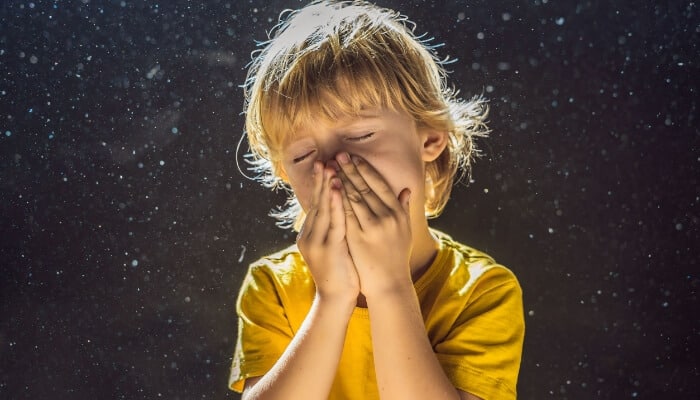Indoor Air Quality Services Near Champaign, IL
Do you know what's in your home's air that you breathe every day? Invisible airborne pollutants may be lurking and causing worsening allergies, asthma, and other breathing conditions. Lanz, Inc. has solutions tailored to your needs to improve indoor air quality and deliver fresher, cleaner, safer air to every room. We will assess your Champaign, IL, home's needs, find the right solution to eliminate pesky contaminants, and install your new system with expert care.

1. Air Purification and Ventilation
Supplying clean air indoors is one of the best ways to improve indoor air quality. For adequate fresh air, keep windows and doors shut as much as possible. You may also consider installing an air purification and ventilation system to boost indoor comfort. We offer a wide range of products to meet your unique needs.
GPS - iWave
- Patent pending self-cleaning design. No maintenance or replacement parts.
- Kills mold, bacteria, and viruses.
- Reduces allergens, smoke, static electricity, and other airborne particles.
UV Lights
- Ozone free.
- Reduces smoke, odors, VOCs, allergens, dust, and particles.
- Reduces airborne and surface microbial, bacteria, viruses, and mold.
Fresh Air Ventilation
- Products like Energy Recovery Ventilators (ERV), Heat Recovery Ventilation (HRV), and fresh air ventilation systems bring in fresh air to dilute pollutants and particulates from the air.
- HRVs are primarily used in warmer climates.
- Highly energy efficient to pull the stale air from your home while replacing it with fresh air from outside.
- Ventilators are needed for highly efficient structures to make sure that indoor air remains fresh and healthy.
2. Humidity Control
Humidity plays a major role in indoor air quality and human health. The ability to add and remove humidity as needed to your home has a positive effect on your overall health. The optimal level of humidity to maintain in your home is between 35 and 60. Mold, dust mites, and other air pollutants thrive outside of that range. To maintain the ideal level throughout your entire some, you should add humidity with a whole-home evaporative or steam humidifier and remove humidity when needed with a dehumidifier.
Humidifiers and Dehumidifiers
These devices help maintain a healthy and comfortable moisture balance in the home’s air, regardless of the season. During wet and rainy seasons, a whole-house dehumidifier dries the air; during dry seasons, a humidifier adds moisture. All units are built right into the heating and cooling system and serve the entire house, not just one or two rooms.
When humidity is too high or low in your home, there is a greater risk of infection, asthma attacks, dry skin, dry eyes, and impaired brain functions. If you're unsure which system your home needs, the team at Lanz, Inc. is here to help!
3. Filtration
Dirty and neglected filters are the #1 cause of HVAC system failure. Keeping your filters and system clean can reduce your energy consumption by up to 15% according to the U.S. Department of Energy. Our team will help you navigate filter sizes, MERV ratings, and more to find and maintain the right filters for your HVAC system. You can control air pollutants at the source by doing the following:
- Vacuum rugs, carpets, and pet bedding frequently with a HEPA-quality vacuum cleaner.
- Wash bedding in hot water weekly and dry it on a hot cycle to kill dust mites.
- Regularly dusting furniture and hardwood floors.
- Keep pets off the furniture and out of the bedroom to reduce pet dander.
- Avoid smoking inside.
- Consider cleaning your ducts.
You may also consider installing a whole-house air cleaning system in your central HVAC to help remove airborne pollutants. Electronic Air Cleaners remove airborne particles. The main categories of indoor air pollutants include:
- Gases & Vapors Known as Volatile Organic Compounds (VOCs).
- Biological Compounds (Viruses & Bacteria).
- Humidity.
The first line of defense against these is your air filter. Even if it doesn’t look dirty, there are still tiny micron particles that clog it making your system work harder than it needs to.
Home Ventilation Systems
If your home is well-sealed and insulated, it may inadvertently trap air pollutants generated by building materials, furnishings, cooking, and even cleaning products. Home ventilation systems exchange stale, polluted air for fresh outside air at recommended rates without wasting energy.
ASHRAE and the CDC have recently proposed guidance for operating buildings during the COVID–19 pandemic; the guidance related to HVAC is as follows.
ASHRAE Guidance
- Increase outdoor air ventilation (use caution in highly polluted areas); with a lower population in the building, this increases the effective dilution ventilation per person.
- Improve central air filtration to the MERV-13 or the highest compatible with the filter rack, and seal the edges of the filter to limit bypass. The Lanz Comfort Family includes all standard filters.
- Keep systems running longer hours, if possible 24/7, to enhance the two actions above.
- Consider portable room air cleaners with HEPA filters.
- Consider UVGI (ultraviolet germicidal irradiation), protecting occupants from radiation, particularly in high-risk spaces such as waiting rooms, prisons, and shelters.
CDC Guidance
- Consider improving the engineering controls using the building ventilation system.
- Increase ventilation rates.
- Increase the percentage of outdoor air that circulates into the system.
Programmable Thermostats
Programmable thermostats are not only convenient, but they are also a proven way to save up to 30% of your heating and cooling energy costs. Zone controls allow you to adjust the temperature of various areas within your home from a control panel that operates dampers in your forced-air heating and cooling system. They also help lower your energy bills by enabling you to heat or cool only the zones that you are using.
Tips for Maintaining Air Quality in the Home
- Stay aware of local weather reports for news of pollution blown in from fires nearby or other areas. Many communities offer forecasts for the next day’s expected air pollution levels. Levels predicted to be orange, red, or purple days signal unhealthy levels of ozone. However, pollution from fires may bring unhealthy levels of soot or fine particle pollution, which may be on days when ozone levels are not high.
- Limit time spent outdoors when air pollution from fires (or other sources) is predicted to be high, limit time spent outdoors and avoid exercise outside, especially if you have asthma, lung disease, or are a child or senior.
- Use a high-efficiency furnace filter and replace it every two to three months. A high-efficiency filter not only protects the furnace but can also capture up to 30 times more pollutants such as smoke, pet dander, and pollen than standard fiberglass filters. So that air is always passing through the filter, run the furnace fan continuously regardless of the outdoor temperature. To do so, set the furnace thermostat to the “on,” rather than the “auto,” position.
- Have a professional inspect the furnace once a year to make sure that the air intake is adequate and the unit is operating at peak efficiency. A smooth-running furnace helps the filter capture more soot particles in the home.
- Prohibit smoking in the home.
- Make sure gas cooking appliances are vented to the outdoors.
When you're ready to find the right solution to improve your home's indoor air, we're here to help! We know the ins and out of IAQ so you don't have to. Why call anyone else? Reach out to us today at 217-394-1380 to find the perfect solution.
FAQs
Common indoor air pollutants include volatile organic compounds (VOCs), which are emitted from products like cleaning supplies and furnishings and can lead to respiratory issues. Radon is a naturally occurring radioactive gas that poses health risks when it accumulates indoors. Dust mites and pet dander are common allergens found in homes. Tobacco smoke is a major indoor pollutant, causing various health problems. Additionally, mold spores can thrive in damp areas and trigger allergies and respiratory ailments. Adequate ventilation, air purifiers, and regular cleaning are essential for mitigating these indoor air pollutants and improving indoor air quality.
The type of filter, how often the purifier is used, and the quality of the interior air are some of the variables that affect how often air purifier filters need to be changed. Pre-filters or washable filters should normally be cleaned or changed every one to three months, whereas HEPA filters, which collect smaller particles, typically last between six and twelve months. Carbon filters typically last between three and six months and are excellent against smells and pollutants. However, settings with high levels of pollution or usage can call for more frequent replacements. To maintain maximum air purification effectiveness, it is crucial to refer to the manufacturer's guidelines and constantly check the quality of the filters.





